maybe if I collect enough references I'll actually make something
Don't wanna be here? Send us removal request.
Text
Small fantasy worldbuilding elements you might want to think about:
A currency that isn’t gold-standard/having gold be as valuable as tin
A currency that runs entirely on a perishable resource, like cocoa beans
A clock that isn’t 24-hours
More or less than four seasons/seasons other than the ones we know
Fantastical weather patterns like irregular cloud formations, iridescent rain
Multiple moons/no moon
Planetary rings
A northern lights effect, but near the equator
Roads that aren’t brown or grey/black, like San Juan’s blue bricks
Jewelry beyond precious gems and metals
Marriage signifiers other than wedding bands
The husband taking the wife's name / newlyweds inventing a new surname upon marriage
No concept of virginity or bastardry
More than 2 genders/no concept of gender
Monotheism, but not creationism
Gods that don’t look like people
Domesticated pets that aren’t re-skinned dogs and cats
Some normalized supernatural element that has nothing to do with the plot
Magical communication that isn’t Fantasy Zoom
“Books” that aren’t bound or scrolls
A nonverbal means of communicating, like sign language
A race of people who are obligate carnivores/ vegetarians/ vegans/ pescatarians (not religious, biological imperative)
I’ve done about half of these myself in one WIP or another and a little detail here or there goes a long way in reminding the audience that this isn’t Kansas anymore.
42K notes
·
View notes
Text
If your plot feels flat, STUDY it! Your story might be lacking...
Stakes - What would happen if the protagonist failed? Would it really be such a bad thing if it happened?
Thematic relevance - Do the events of the story speak to a greater emotional or moral message? Is the conflict resolved in a way that befits the theme?
Urgency - How much time does the protagonist have to complete their goal? Are there multiple factors complicating the situation?
Drive - What motivates the protagonist? Are they an active player in the story, or are they repeatedly getting pushed around by external forces? Could you swap them out for a different character with no impact on the plot? On the flip side, do the other characters have sensible motivations of their own?
Yield - Is there foreshadowing? Do the protagonist's choices have unforeseen consequences down the road? Do they use knowledge or clues from the beginning, to help them in the end? Do they learn things about the other characters that weren't immediately obvious?
94K notes
·
View notes
Text


It is done (enough)!
I would hype it up more but this is really really simple. It randomly generates a set of symbols, colors, and a word, and then the expected thing to do with those is you draw some sort of character based off the result you get. So it's just an art challenge toy thingy.
There are also some practical features like you can lock parts of the result in place to rerandomize the rest, or hide parts of the generation you don't care about (like if you want to pick your own colors or hate the words being there)
You can try it out over on itch.io!
It should run in browser, but there's also a downloadable version for Windows if you want to use it offline. (No mac/linux versions for now, because I don't have appropriate computers to test those on and I...don't want to deal with mac's developer accounts or whatever their problem is...)
Here's something I made from one of the results I got for the sake of example:

(It's a bit of a rushed drawing sorry I just wanted to get the actual generator out there)
I hope everyone has fun with it :]
17K notes
·
View notes
Text
gonna show u guys a little opalescent highlight hack i threw together today
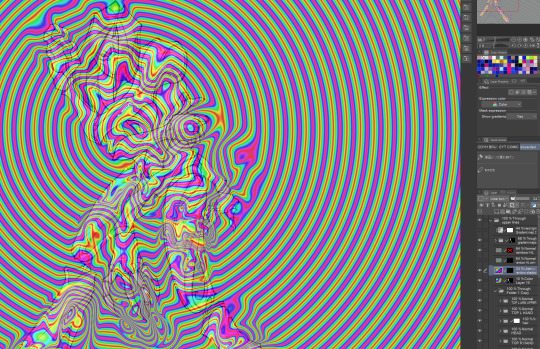
rainbow gradient above your main figure (i usually have all my main figure folders/layers in one big folder, so i can clip gradient maps + adjustments to it!). liquify tool to push the colors around a bit. STAY WITH ME I KNOW IT LOOKS STUPID RN I'M GOING SOMEWHERE WITH THIS
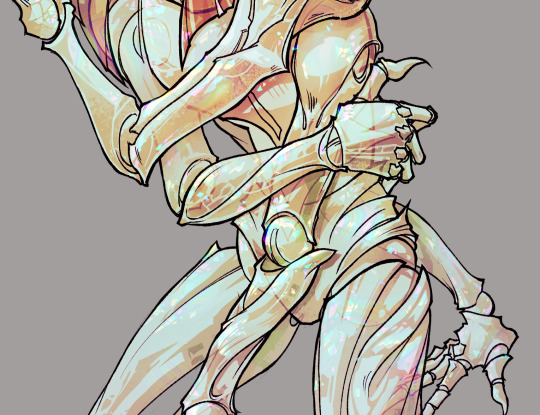
THEN: set it to add/glow (or the equivalent in ur drawing program), lower the opacity a bit, and apply a layer mask. then u can edit the mask with whatever tools you like to create rainbow highlights!!
in this case i'm mostly using the lasso fill tool to chip out little facets, but i've also done some soft airbrushing to bring in larger rainbow swirls in some areas. it's pretty subtle here, but you can see it better when i remove the gradient map that's above everything, since below i'm working in greyscale:
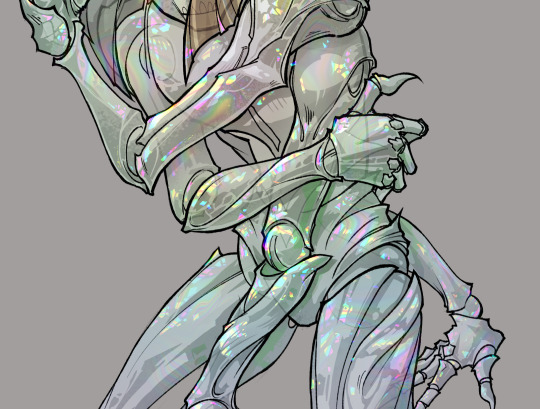
more granular rambling beneath the cut!
u could also just do this with a brush that has color jitter, but what i like about using layer masks for highlight/shading layers is how simple and reversible it makes everything. i can use whatever brushes i want, and erasing/redoing things is super low stakes, which is great when i often approach this stuff with a super trial-and-error approach.
example: have u ever thrown a gradient w multiple colors over an entire piece, set it to multiply etc, and then tried to erase it away to carve out shadows/highlights? it's super frustrating, bc it looks really good, but if u erase something and then change ur mind later, u basically would have to like. recreate the gradient in the area u want to cover up again. that's how i used to do things before figuring out layer masks!! but masking basically creates a version of this with INFINITE undo bc u can erase/re-place the base layer whenever u want.
anyway, back to rambling about this specific method:
i actually have TWO of these layers on this piece (one with the liquified swirls shown above, and another that's just a normal concentric circle gradient with much broader stripes) so i can vary the highlights easily as needed.
since i've basically hidden the rainbow pattern from myself, the colors in each brushstroke i make will kind of be a surprise, which isn't always great -- but easily fixable! for example, if i carve out a highlight and it turns out the rainbow pattern in that area is way too stripey, i can just switch from editing the mask to editing the main layer and blur that spot a bit.
also, this isn't a full explanation of the overall transparency effect in these screencaps! there's other layer stuff happening below the rainbow highlights, but the short version is i have all this character's body parts in different folders, each with their own lineart and background fill, and then the fill opacity is lowered and there's multiply layers clipped to that -- blah blah it's a whole thing. maybe i'll have a whole rundown on this on patreon later. uhhh i think that's it tho! i hope u get something useful out of this extremely specific thing i did lmao
12K notes
·
View notes
Text

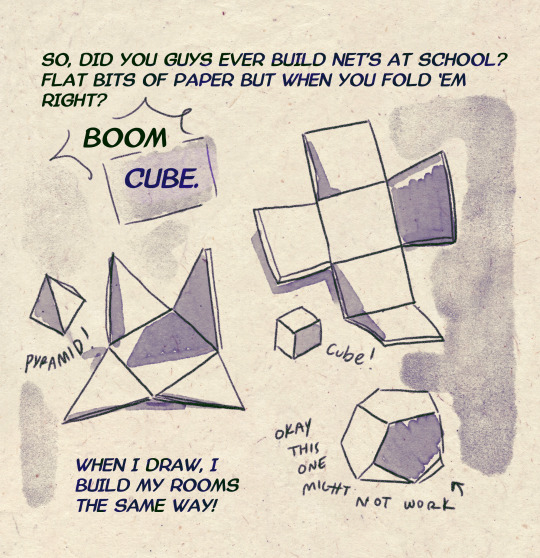
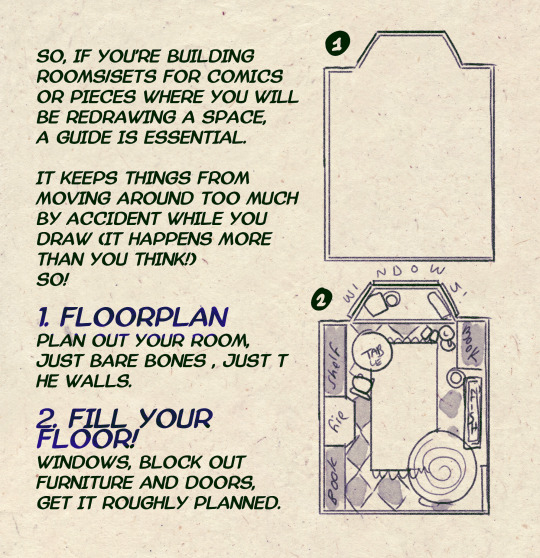
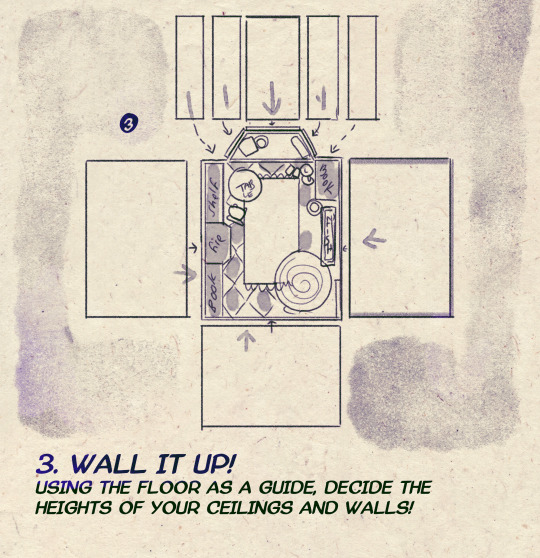
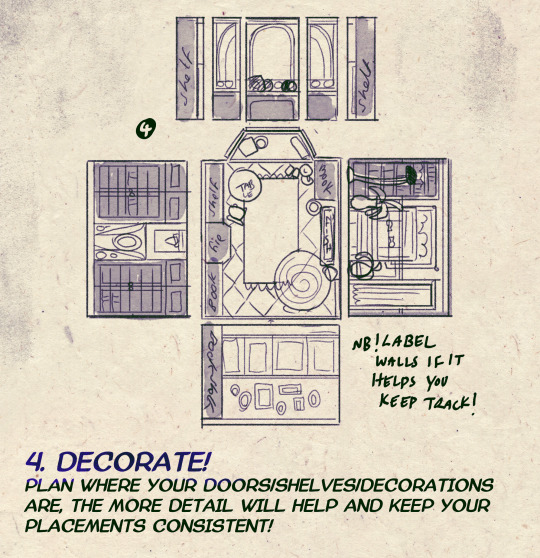

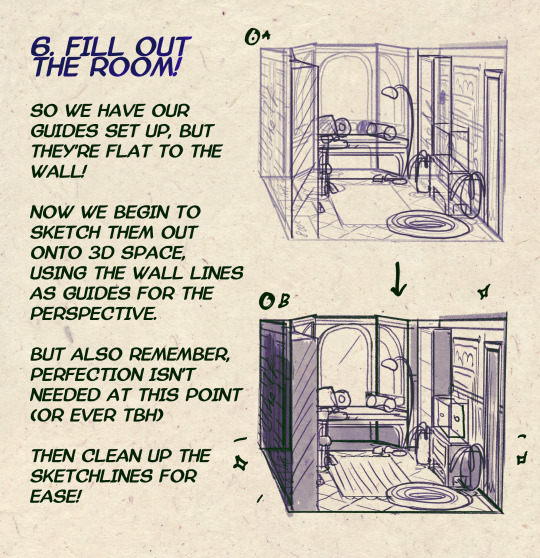

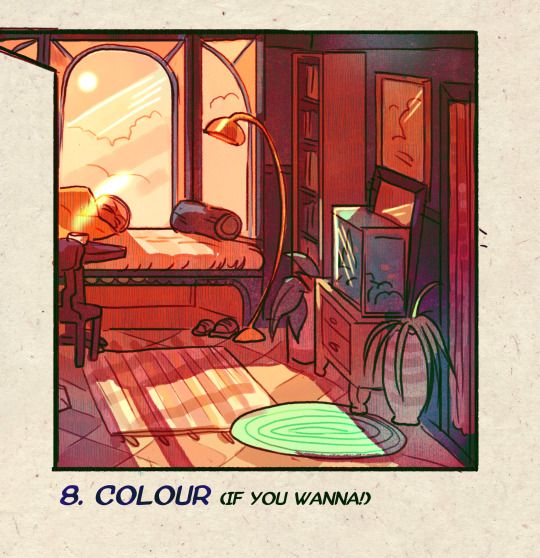
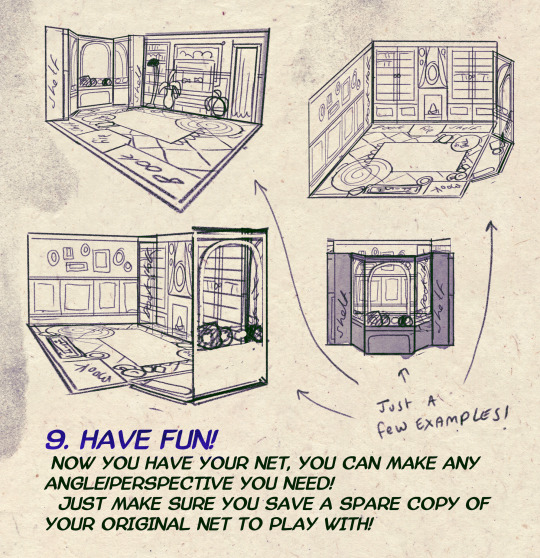
I made a Room Building tutorial! Lemme know if it helps! 🧡
Tip me here| Commission info here!
42K notes
·
View notes
Text
reminder to worldbuilders: don't get caught up in things that aren't important to the story you're writing, like plot and characters! instead, try to focus on what readers actually care about: detailed plate tectonics
148K notes
·
View notes
Text
Writing Resources List

I use my blog to share writing resources that I’ve collected over the years. I’ve recently gotten some new followers, so I thought I would make a list of many of these resources for easy reference.
(However, this is not a complete list of all the resources I’ve posted. For more writing resources, feel free to check out my blog.)
Encouragement for Writers
Writer’s Block & Procrastination
Writing Your Story’s Plot
How to Write a Scene
Choosing a Setting for Your Story
Character Arc & Character Development
Character Traits
How to Write Heroes & Villains
Elemental Magic & Superpowers
Writing Magic Systems
Fantasy Writing & World-Building
Writing Fight Scenes
Swords and Bows
Writing Mermaids
Writing Relationships & Romance
Romance & Relationship Prompts
+
I’m a writer, poet, and editor. I share writing resources that I’ve collected over the years and found helpful for my own writing. If you like my blog, follow me for more resources! ♡
4K notes
·
View notes
Text
Writing Description Notes:
Updated 9th September 2024 More writing tips, review tips & writing description notes
Facial Expressions
Masking Emotions
Smiles/Smirks/Grins
Eye Contact/Eye Movements
Blushing
Voice/Tone
Body Language/Idle Movement
Thoughts/Thinking/Focusing/Distracted
Silence
Memories
Happy/Content/Comforted
Love/Romance
Sadness/Crying/Hurt
Confidence/Determination/Hopeful
Surprised/Shocked
Guilt/Regret
Disgusted/Jealous
Uncertain/Doubtful/Worried
Anger/Rage
Laughter
Confused
Speechless/Tongue Tied
Fear/Terrified
Mental Pain
Physical Pain
Tired/Drowsy/Exhausted
Eating
Drinking
Warm/Hot
53K notes
·
View notes
Text
Writing Intimacy
i often see writers sharing a sentiment of struggling with writing kiss scenes which honestly bleeds into other portrayals of physical intimacy. i see it a lot in modernized styles of writing popularized by the recent trend in publishing to encourage short, choppy sentences and few adverbs, even less descriptive language. this makes intimacy come across awkward, like someone writing a script or clumsy recounting of events rather than a beautiful paragraph of human connection.
or just plane horniness. but hey, horny doesn't have to be mutually exclusive with poetic or sensual.
shallow example: they kissed desperately, tongues swirling and she moaned. it made her feel warm inside.
in depth example: she reached for the other woman slowly and with a small measure of uncertainty. the moment her fingers brushed the sharp, soft jaw of her companion, eliza's hesitance slid away. the first kiss was gentle when she finally closed the distance between them. she pressed her lips lightly to gabriella's in silent exploration. a tender question. gabriella answered by meeting her kiss with a firmer one of her own. eliza felt the woman's fingers curling into her umber hair, fingernails scraping along her scalp. everything inside eliza relaxed and the nervousness uncoiled from her gut. a warm buzz of energy sunk through her flesh down to the very core of her soul. this was right. this was always where she needed to be.
the first complaint i see regards discomfort in writing a kiss, feeling like one is intruding on the characters. the only way to get around this is to practice. anything that makes you uncomfortable in writing is something you should explore. writing is at its best when we are pushing the envelope of our own comfort zones. if it feels cringy, if it feels too intimate, too weird, too intrusive, good. do it anyway! try different styles, practice it, think about which parts of it make you balk the most and then explore that, dissect it and dive into getting comfortable with the portrayal of human connection.
of course the biggest part comes to not knowing what to say other than "they kissed" or, of course, the tried and true "their lips crashed and their tongues battled for dominance" 😐. so this is my best advice: think beyond the mouth. okay, we know their mouths are mashing. but what are their hands doing? are they touching one another's hair? are they scratching or gripping desperately at one another? are they gliding their hands along each other's body or are they wrapping their arms tightly to hold each other close? do they sigh? do they groan? do they relax? do they tense? are they comfortable with each other or giddy and uncertain? is it a relief, or is it bringing more questions? is it building tension or finally breaking it?
get descriptive with the emotions. how is it making the main character/pov holder feel? how are they carrying those emotions in their body? how do they feel the desire in their body? desire is not just felt below the belt. it's in the gut, it's in the chest, it's in the flushing of cheeks, the chills beneath the skin, the goosebumps over the surface of the flesh. everyone has different pleasure zones. a kiss might not always lead desire for overtly sexual touches. a kiss might lead to the desire for an embrace. a kiss might lead to the impulse to bite or lick at other areas. a kiss could awaken desire to be caressed or caress the neck, the shoulder, the back, the arms etc. describe that desire, show those impulses of pleasure and affection.
of course there is the tactile. what does the love interest taste like? what do they smell like? how do they kiss? rough and greedy? slow and sensual? explorative and hesitant? expertly or clumsily? how does it feel to be kissed by them? how does it feel to kiss them?
i.e. examine who these individuals are, what their motives and feelings are within that moment, who they are together, what it looks like when these two individuals come together. a kiss is not about the mouth. it's about opening the door to vulnerability and desire in one's entire body and soul.
13K notes
·
View notes
Text
How to Make Your Characters Almost Cry
Tears are powerful, but do you know what's more impactful? The struggle to hold them back. This post is for all your hard-hearted stoic characters who'd never shed a tear before another, and aims to help you make them breakdown realistically.
The Physical Signs of Holding Back Tears
Heavy Eyelids, Heavy Heart Your character's eyelids feel weighted, as if the tears themselves are dragging them down. Their vision blurs—not quite enough to spill over, but enough to remind them of the dam threatening to break.
The Involuntary Sniffle They sniffle, not because their nose is running, but because their body is desperately trying to regulate itself, to suppress the wave of emotion threatening to take over.
Burning Eyes Their eyes sting from the effort of restraint, from the battle between pride and vulnerability. If they try too hard to hold back, the whites of their eyes start turning red, a telltale sign of the tears they've refused to let go.
The Trembling Lips Like a child struggling not to cry, their lips quiver. The shame of it fuels their determination to stay composed, leading them to clench their fists, grip their sleeves, or dig their nails into the nearest surface—anything to regain control.
The Fear of Blinking Closing their eyes means surrender. The second their lashes meet, the memories, the pain, the heartbreak will surge forward, and the tears will follow. So they force themselves to keep staring—at the floor, at a blank wall, at anything that won’t remind them of why they’re breaking.
The Coping Mechanisms: Pretending It’s Fine
A Steady Gaze & A Deep Breath To mask the turmoil, they focus on a neutral object, inhale slowly, and steel themselves. If they can get through this one breath, they can get through the next.
Turning Away to Swipe at Their Eyes When they do need to wipe their eyes, they do it quickly, casually, as if brushing off a speck of dust rather than wiping away the proof of their emotions.
Masking the Pain with a Different Emotion Anger, sarcasm, even laughter—any strong emotion can serve as a shield. A snappy response, a bitter chuckle, a sharp inhale—each is a carefully chosen defence against vulnerability.
Why This Matters
Letting your character fight their tears instead of immediately breaking down makes the scene hit harder. It shows their internal struggle, their resistance, and their need to stay composed even when they’re crumbling.
This is written based off of personal experience as someone who goes through this cycle a lot (emotional vulnerability who?) and some inspo from other books/articles
10K notes
·
View notes
Text
So my problem with most ‘get to know your character’ questioneers is that they’re full of questions that just aren’t that important (what color eyes do they have) too hard to answer right away (what is their greatest fear) or are just impossible to answer (what is their favorite movie.) Like no one has one single favorite movie. And even if they do the answer changes.
If I’m doing this exercise, I want 7-10 questions to get the character feeling real in my head. So I thought I’d share the ones that get me (and my students) good results:
What is the character’s go-to drink order? (this one gets into how do they like to be publicly perceived, because there is always some level of theatricality to ordering drinks at a bar/resturant)
What is their grooming routine? (how do they treat themselves in private)
What was their most expensive purchase/where does their disposable income go? (Gets you thinking about socio-economic class, values, and how they spend their leisure time)
Do they have any scars or tattoos? (good way to get into literal backstory)
What was the last time they cried, and under what circumstances? (Good way to get some *emotional* backstory in.)
Are they an oldest, middle, youngest or only child? (This one might be a me thing, because I LOVE writing/reading about family dynamics, but knowing what kinds of things were ‘normal’ for them growing up is important.)
Describe the shoes they’re wearing. (This is a big catch all, gets into money, taste, practicality, level of wear, level of repair, literally what kind of shoes they require to live their life.)
Describe the place where they sleep. (ie what does their safe space look like. How much (or how little) care / decoration / personal touch goes into it.)
What is their favorite holiday? (How do they relate to their culture/outside world. Also fun is least favorite holiday.)
What objects do they always carry around with them? (What do they need for their normal, day-to-day routine? What does ‘normal’ even look like for them.)
59K notes
·
View notes
Text
I love you PBS I love you NPR I love you public libraries I love you wikipedia I love you project gutenberg I love you librivox I love you libby I love you hoopla I love you openlibrary I love you internet archive I love you resources that make information free and accessible to the public
94K notes
·
View notes
Text
i love when characters lie to themselves in the complete privacy of their own minds
63K notes
·
View notes
Text
i love old science fiction because it’s all like “IT’S THE DISTANT YEAR TWO THOUSAND AND THREE AND MAN IS EXPLORING THE DEEP CORNERS OF THE UNIVERSE” like god bless you old sci-fi you had such high hopes for us
435K notes
·
View notes
Text

anon asked about the sketch brush i used for my last tutorial!
most of my speed sketches lately are just the default clip studio paint 'oil paint' brush, and "cleaned" (lightening detail lines + minor shading) with a standard round brush on low opacity 👍
697 notes
·
View notes
Text
some words for worldbuilding (pt. 1)
Air
billow, breath, bubble, draft, effervescence, fumes, puff, vapor
Arena
aquarium, bazaar, coliseum, field, hall, mecca, stage
Building
abbey, architecture, armory, asylum, bakery, bar, booth, cathedral, club, construction, court, department store, dock, edifice, emergency room, factory, food court, fort/fortress, framework, garrison, greasy spoon, hacienda, hangout, headquarters, hotel, inn, institute/institution, jetty, laboratory, mansion, mental hospital, monastery, mosque, museum, nursing home, office, pavilion, penitentiary, plant, prison, rampart, repository, ruins, sanctuary, shrine, skyscraper, stockade, storeroom, structure, temple, theater/theatre, treasury, warehouse, wharf
City
capital, metropolis, town, village
Furniture
altar, banister, bench, booth, bunk, cabinet, chair, couch, crib, davenport, dresser, furnishings, futon, jetty, lectern, partition, perch, platform, pulpit, rail/railing, screen, secretary, stand, wardrobe
Geographic division
area, county, desert, dynasty, kingdom, outskirts, quarter, sector, suburb, territory, tract, zone
Habitat
abode, ecosystem, environmentalist, habitat/habitation, harbor, home, land, nest, paradise, premises, refuge, settlement, tent
Habitat, human: accommodations, apartment, barracks, cabin, castle, condominium, convent, domesticity, dungeon, element, encampment, estate, grange, hacienda, home, house, housing, hut, jail, lodging, madhouse, monastery, neighborhood, old country, palace, prison, reservation, resort, sanctuary, shanty, suite, vacancy, villa
Habitat, rural: barn, burrow, conservatory, desert, farm, forest, grange, jungle, sanctuary, wilderness/wilds, wood/woods
Land
abyss, avalanche, bank, bay, bed, bluff, campus, cape, cavern, cliff, compost, cove, crevice/crevasse, dirt, downgrade, dune, elevation, estuary, expanse, field, fossil, garden, glacier, gorge, green, ground, gulf, harbor, hillock, inlet, knoll, landscape, lawn, lot, marshy, menagerie, mine, moat, mound, mountainous, nature, outlook, park, patio, pit, plateau, plaza, porch, prairie, projection, property, quagmire, ravine, ridge, savanna, shelf, soil, stack, table, trench, tundra, valley, well, wood/woods, yard
Nation
country, home, land, nationality, soil, state
Personal item
adornment, amulet, beads, best-seller, briefcase, cache, cargo, charm, contraceptive, disguise, effects, equipment, favorite, gem, glasses, handbag, jewelry, knickknack, luggage, marionette, memorabilia, necklace, novelty, object d’art, odds-on-favorite, paraphernalia, pledge, possession, pride, puppet, purse, resources, ring, souvenir, stuff, supplies, sustenance, thing/things, trappings, trifle, valuable
Planet
cosmos, Earth, galaxy, moon, planet, sphere, world
Region
capital, commonwealth, quarter, region, settlement, suburb
Room
alcove, attic, bath, bedroom, boutique, cellar, den, enclosure, foyer, gin mill, hall, lavatory, loft, outhouse, parlor, restaurant, saloon, shop, stage, store, tenement, theater/theatre, vestibule
Shape
angular, beaten, billowy, checkered, concave, conical/conic, crescent, curly, deformed, elliptical, flat, gnarled, kinky, misshapen, obtuse, round, shapeless, spiral, straight
Vehicle
camper, conveyance, motorcade, transport
Vehicle, air: aircraft, armada, blimp, dirigible, helicopter, shuttle, UFO
Vehicle, land: ambulance, bicycle, car, cherry-picker, dolly, excavator, model, traffic, truck
Vehicle, water: armada, boat, craft, fleet, sailboat, yacht
Water
abyss, aqueduct, basin, beach, blackball, brook, cape, channel, condensation, creek, deep, estuary, fountain, gulf, heading, inlet, lake, oasis, pond, promontory, reservoir, sea, spray, strait, tide, wash, wave, whirlpool
NOTE
The above are concepts classified according to subject and usage. It not only helps writers and thinkers to organize their ideas but leads them from those very ideas to the words that can best express them.
It was, in part, created to turn an idea into a specific word. By linking together the main entries that share similar concepts, the index makes possible creative semantic connections between words in our language, stimulating thought and broadening vocabulary.
Source ⚜ Writing Basics & Refreshers ⚜ On Vocabulary
2K notes
·
View notes
Text
Skip Google for Research
As Google has worked to overtake the internet, its search algorithm has not just gotten worse. It has been designed to prioritize advertisers and popular pages often times excluding pages and content that better matches your search terms
As a writer in need of information for my stories, I find this unacceptable. As a proponent of availability of information so the populace can actually educate itself, it is unforgivable.
Below is a concise list of useful research sites compiled by Edward Clark over on Facebook. I was familiar with some, but not all of these.
⁂
Google is so powerful that it “hides” other search systems from us. We just don’t know the existence of most of them. Meanwhile, there are still a huge number of excellent searchers in the world who specialize in books, science, other smart information. Keep a list of sites you never heard of.
www.refseek.com - Academic Resource Search. More than a billion sources: encyclopedia, monographies, magazines.
www.worldcat.org - a search for the contents of 20 thousand worldwide libraries. Find out where lies the nearest rare book you need.
https://link.springer.com - access to more than 10 million scientific documents: books, articles, research protocols.
www.bioline.org.br is a library of scientific bioscience journals published in developing countries.
http://repec.org - volunteers from 102 countries have collected almost 4 million publications on economics and related science.
www.science.gov is an American state search engine on 2200+ scientific sites. More than 200 million articles are indexed.
www.pdfdrive.com is the largest website for free download of books in PDF format. Claiming over 225 million names.
www.base-search.net is one of the most powerful researches on academic studies texts. More than 100 million scientific documents, 70% of them are free
303K notes
·
View notes